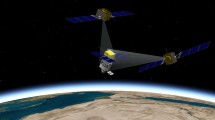Abstract
The purpose of this paper is to show that absolute orbit determination can be achieved based on spacecraft formation. The relative position vectors expressed in the inertial frame are used as measurements. In this scheme, the optical camera is applied to measure the relative line-of-sight (LOS) angles, i.e., the azimuth and elevation. The LIDAR (Light radio Detecting And Ranging) or radar is used to measure the range and we assume that high-accuracy inertial attitude is available. When more deputies are included in the formation, the formation configuration is optimized from the perspective of the Fisher information theory. Considering the limitation on the field of view (FOV) of cameras, the visibility of spacecraft and the installation of cameras are investigated. In simulations, an extended Kalman filter (EKF) is used to estimate the position and velocity. The results show that the navigation accuracy can be enhanced by using more deputies and the installation of cameras significantly affects the navigation performance.





















Similar content being viewed by others
References
Alfriend, K.T., Vadali, S.R., Gurfil, P., How, J., Breger, L.S.: Spacecraft Formation Flying: Dynamics, Control and Navigation (2009). Butterworth-Heinemann
Bandyopadhyay, S., Foust, R., Subramanian, G.P., Chung, S.J., Hadaegh, F.Y.: Review of formation flying and constellation missions using nanosatellites. J. Spacecr. Rockets 53, 567 (2016). https://doi.org/10.2514/1.A33291
Bar-Shalom, Y., Li, X.R., Kirubarajan, T.: Estimation with Applications to Tracking and Navigation. Wiley, New York (2002). https://doi.org/10.1002/0471221279.ch3
Brown, R.G., Hwang, P.Y.C.: Introduction to Random Signals and Applied Kalman Filtering. Wiley, New York (1997)
Christian, J.A., Robinson, S.B., D’Souza, C.N., Ruiz, J.P.: Cooperative relative navigation of spacecraft using flash light detection and ranging sensors. J. Guid. Control Dyn. 37, 452 (2014). https://doi.org/10.2514/1.61234
Crassidis, J.L., Junkins, J.L.: Optimal Estimation of Dynamic Systems, 2nd edn. Chapman & Hall, London (2011)
D’Amico, S., Montenbruck, O.: Proximity operations of formation-flying spacecraft using an eccentricity/inclination vector separation. J. Guid. Control Dyn. 29, 554 (2009). https://doi.org/10.2514/1.15114
D’Amico, S., Ardaens, J.S., Larsson, R.: Spaceborne autonomous formation-flying experiment on the PRISMA mission. J. Guid. Control Dyn. 35, 834 (2012). https://doi.org/10.2514/1.55638
Elsaka, B., Kusche, J., Ilk, K.H.: Recovery of the Earth’s gravity field from formation-flying satellites: temporal aliasing issues. Adv. Space Res. 50, 1534 (2012). https://doi.org/10.1016/j.asr.2012.07.016
Gelb, A.: Applied Optimal Estimation. MIT Press, Cambridge (1974). Chap. 3
Hill, K., Born, G.: Autonomous interplanetary orbit determination using satellite-to-satellite tracking. J. Guid. Control Dyn. 30, 679 (2007). https://doi.org/10.2514/1.24574
Huang, P.F., Chen, L., Zhang, B., Meng, Z.J., Liu, Z.X.: Autonomous rendezvous and docking with nonfull field of view for tethered space robot. Int. J. Aerosp. Eng. 2017, 3162349 (2017)
Huxel, P.J., Bishop, R.H.: Navigation algorithms and observability analysis for formation flying missions. J. Guid. Control Dyn. 32, 1218 (2009). https://doi.org/10.2514/1.41288
Jauffret, C.: Observability and Fisher information matrix in nonlinear regression. IEEE Trans. Aerosp. Electron. Syst. 43, 756 (2007). https://doi.org/10.1109/TAES.2007.4285368
Kang, W., Ross, I.M., Pham, K., Gong, Q.: Autonomous observability of networked multisatellite systems. J. Guid. Control Dyn. 32, 869 (2009). https://doi.org/10.2514/1.38826
Lemoine, F.G., Smith, D.E., Rowlands, D.D., Zuber, M.T., Neumann, G.A., Chinn, D.S., Pavlis, D.E.: An improved solution of the gravity field of Mars (GMM-2B) from Mars Global Surveyor. J. Geophys. Res. 106, 23359 (2001). https://doi.org/10.1029/2000JE001426
Maessen, D., Gill, E.: Relative state estimation and observability analysis for formation flying satellites. J. Guid. Control Dyn. 35, 321 (2012). https://doi.org/10.2514/1.55125
Markley, F.L.: Autonomous navigation using landmark and intersatellite data. In: AIAA/AAS Astrodynamics Conference, Seatle, WA, Hawaii (1984). AIAA Paper
Markley, F.L.: Approximate Cartesian state transition matrix. J. Astronaut. Sci. 34, 161 (1986)
Ou, Y., Zhang, H.: Observability-based Mars autonomous navigation using formation flying spacecraft. J. Navig. 71, 21 (2018). https://doi.org/10.1017/S0373463317000510
Ou, Y., Zhang, H., Xing, J.: Autonomous orbit determination and observability analysis for formation satellites. In: 2016 35th Chinese Control Conference, CCC, Chengdu (2016). https://doi.org/10.1109/ChiCC.2016.7554179
Psiaki, M.L.: Absolute orbit and gravity determination using relative position measurements between two satellites. J. Guid. Control Dyn. 34, 1285 (2011). https://doi.org/10.2514/1.47560
Roscoe, C.W., Vadali, S.R., Alfriend, K.T., Desai, U.P.: Optimal formation design for magnetospheric multiscale mission using differential orbital elements. J. Guid. Control Dyn. 34, 1070 (2011). https://doi.org/10.2514/1.52484
Schmidt, U.: ASTRO APS autonomous star sensor first year flight experience and operations on AlphaSat (invited). In: AIAA/AAS Astrodynamics Specialist Conference, vol. 701 (2014). American Institute of Aeronautics and Astronautics
Sinopoli, B., Schenato, L., Franceschetti, M., Poolla, K., Jordan, M.I., Sastry, S.S.: Kalman filtering with intermittent observations. IEEE Trans. Autom. Control 49, 9 (2004). https://doi.org/10.1109/TAC.2004.834121
Steven, M.K.: In: Fundamentals of Statistical Signal Processing: Estimation Theory. Prentice Hall Signal Processing Series. Prentice Hall, New York (1993)
Wang, Y., Zheng, W., Sun, S., Li, L.: X-ray pulsar-based navigation using time-differenced measurement. Aerosp. Sci. Technol. 36, 27 (2014). https://doi.org/10.1016/j.ast.2014.03.007
Wang, X., Qin, W., Bai, Y., Cui, N.: A novel decentralized relative navigation algorithm for spacecraft formation flying. Aerosp. Sci. Technol. 48, 28 (2016). https://doi.org/10.1016/j.ast.2015.10.014
Yang, H.X., Vetrisano, M., Vasile, M., Zhang, W.: Autonomous navigation of spacecraft formation in the proximity of minor bodies. Proc. Inst. Mech. Eng., G J. Aerosp. Eng. 230, 189 (2016). https://doi.org/10.1177/0954410015590465
Acknowledgement
This work is supported by the Major Program of National Natural Science Foundation of China under Grant Numbers 61690210 and 61690213.
Author information
Authors and Affiliations
Corresponding author
Appendices
Appendix 1
This appendix gives the calculation of gravity gradient tensors that take into account the \(J_{2}\) perturbation. The tensor is defined as
Each element of the tensor is given as
Appendix 2
The integrations are computed as
Rights and permissions
About this article
Cite this article
Ou, Y., Zhang, H. & Li, B. Absolute orbit determination using line-of-sight vector measurements between formation flying spacecraft. Astrophys Space Sci 363, 76 (2018). https://doi.org/10.1007/s10509-018-3293-2
Received:
Accepted:
Published:
DOI: https://doi.org/10.1007/s10509-018-3293-2



